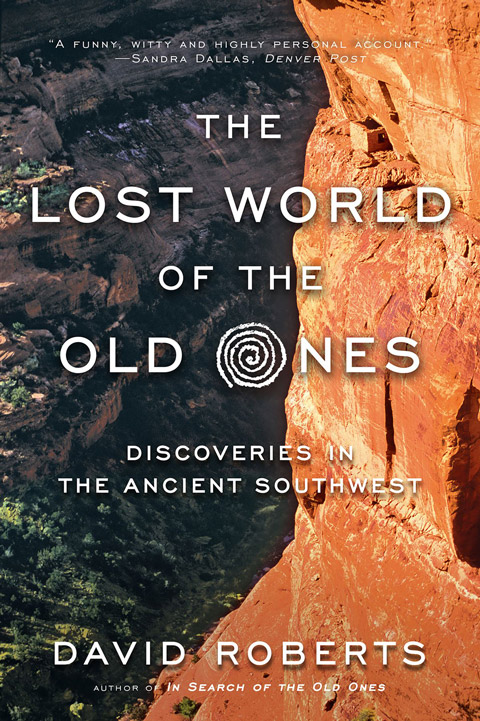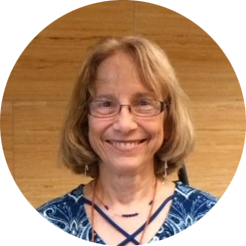

Welcome To
The James Museum from Home
Connect with us through curated content based on our collection. Explore art, movies, books, music, children’s activities and more. Each theme is freshly considered and developed by our curatorial and education teams. We invite you to discover a new way to experience the museum and learn more about our collection.
Theme: Sky
Set your sights above as we explore the sky, from cloud formations to celestial bodies. Discover works of art, books, movies, and creative activities that encourage daydreaming and stargazing.
Selected Artwork
View the sky through the eyes of six artists who offer creative and dramatically different interpretations in their work.
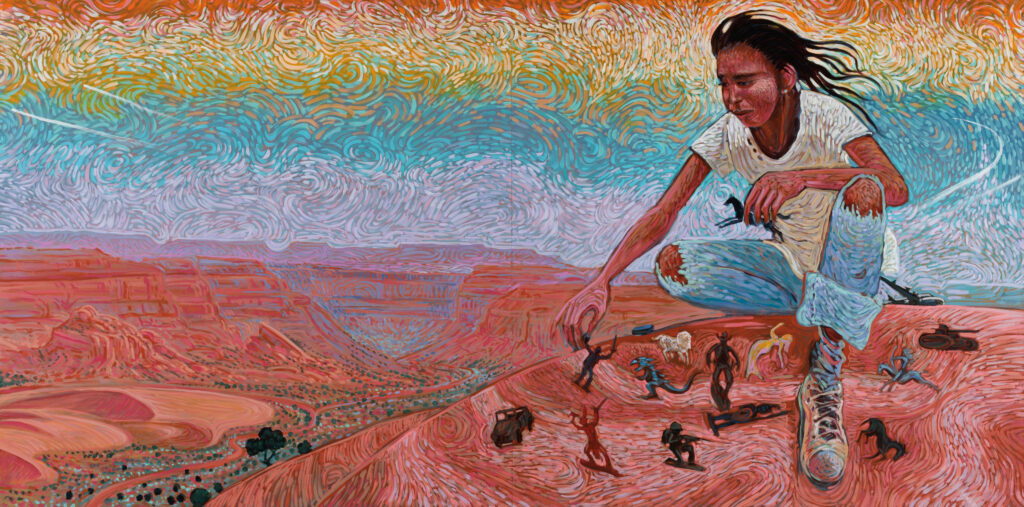
Shonto Begay
Navajo (Diné), born 1954
Composing My World
2013
Acrylic on engineered wood panel (Gessobord)
Art Spotlight
By: Jason M. Wyatt | Collections Manager
In the work Composing My World, painter Shonto Begay depicts a shepherd boy taking a break from his duties to play with toys he brought along for the day. The boy is creating his own story-world with the figurines, a reference by the artist to the Navajo creation myth. Begay was raised with a traditional Navajo upbringing, and like the young boy depicted here, spent his childhood herding sheep in the Kletha Valley in Shonto, Arizona. Begay credits the use of Navajo prayers in getting through a dark period of his childhood when he was taken away from his family and placed in a Bureau of Indian Affairs boarding school.
Begay’s distinct style is best summed up by the artist himself: “The way I paint is like a visual chant. The broken lines, dots and strokes make a rhythm, so the painting is like thousands of syllables.” The undulating and twisting air currents in the sky of Composing My World remind the viewer of Vincent van Gogh’s Post-Impressionistic masterpiece Starry Night. The artist takes the composition of the sky one step further with the use of color to show the five distinct layers of the earth’s atmosphere. Begay likes to remind all people to “Pause in the day to gaze up into the peaks and cast your spirit aloft there where prayers return as droplets of water.”
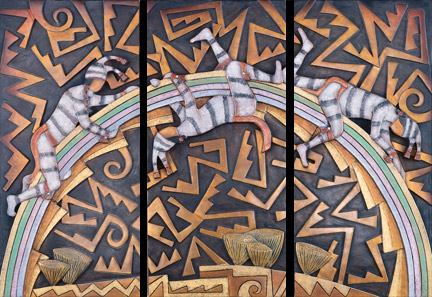
Tammy Garcia
Santa Clara (Kha’p’oo Owingeh), born 1969
High Spirits
2009
Bronze (18/30)
Art Spotlight
By: Caitlin Pendola | Curatorial Associate
In this triptych relief, Garcia has taken on the unique challenge of interpreting the sky in bronze. Sacred Pueblo clowns climb across a rainbow arch above the horizon line. It is common for these clowns to be depicted climbing. Some Pueblo creation stories chronicle the powerful clowns climbing up from the underworld, through the earth, leading the people up to the surface, so they could emerge into the light. Today, they are an important part of ceremonies and celebrations. They perform, using comedy to ridicule hubris and reinforce morals.
Throughout her career, the artist has transmuted tradition and ancestry into contemporary visions. “On principle alone, I reject the labels of ‘traditional’ or ‘non-traditional’… in fact, I have actively dedicated my artwork to re-defining those terms. I enjoy creating pieces for which cannot be categorized… at the same time, what I do is also so strongly rooted in tradition and culture.”
Garcia is also known for her blending of the figurative with the abstract. Here, figurative forms interact with the abstract, geometrical designs that fill the sky. These designs have been a reoccurring theme in Garcia’s art. A descendant of a long line of the famed matriarch of Santa Clara potters, Garcia began as a potter herself. She often used abstract, geometric designs in her clay creations and has continued that pattern, translating the designs into bronze. Her pottery influence is evident here, with this relief-style sculpture, resembling her clay carvings. Whatever the medium, Garcia’s visual storytelling successfully forges new traditions in Native American art.
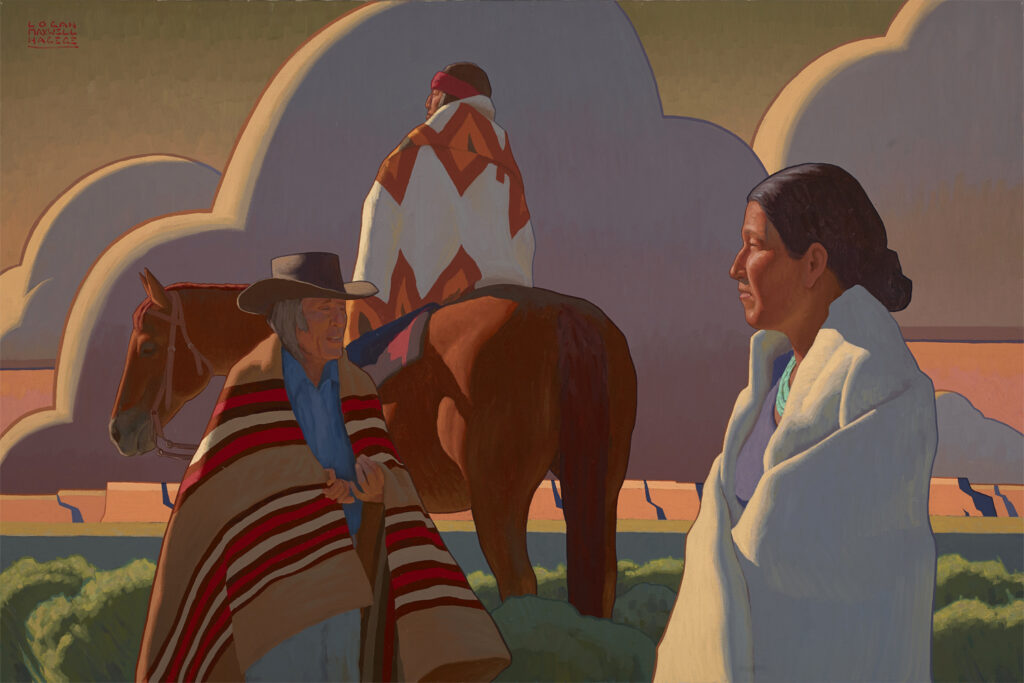
Logan Maxwell Hagege
American, born 1980
Light on the Round Clouds
2013
Oil on canvas
Art Spotlight
By: Caitlin Pendola | Curatorial Associate
On the topic of skies, it would be an injustice not to include the art of Logan Maxwell Hagege (pronounced Ah-jejj). One can spot his signature, bold clouds from a gallery away. They seem to bloom out of the horizon, commanding attention and inviting wonder. His contemporary interpretations of the Southwest are otherworldly enough to fuel your imagination, yet tethered to realism just enough to establish a sense of the people, the place, and its timelessness.
Here, in Light on the Round Clouds, Hagege’s pronounced shapes and eloquently harmonized color tones help to place the viewer in a slightly obscured world. The stripped down, minimalist style is unimposing, welcoming the viewer into the scene. Then, the ambiguous tableau sparks curiosity. Who are these three people? Where are they going? What are they doing? Notice how the land shapes echo the shapes and angles of the figures. Hagege has presented them all as unified. It appears that the land and the people are one.
Another method he uses to blend the real with the imagined is pairing realistically rendered, three-dimensional figures with a flat, two-dimensional background that flirts with abstraction. The juxtaposition gives a nod to the influence of artist Gustav Klimt (1862-1918).
Early in his career Hagege began painting landscapes of the Southwest, drawn to its essence and vast beauty. It was not long before his years of classical art training, working with live models full-time for two years, would lead him to include figures in his compositions. As this natural progression occurred, he began to learn about the people who lived on these lands that he found so inspiring. He has developed a close relationship with the Native American models that he uses. This sharing of culture adds to the underlying depth of his interpretations. “Almost every painting I do is a self-portrait, in a sense… I share some of the spirit with the people in my paintings.”
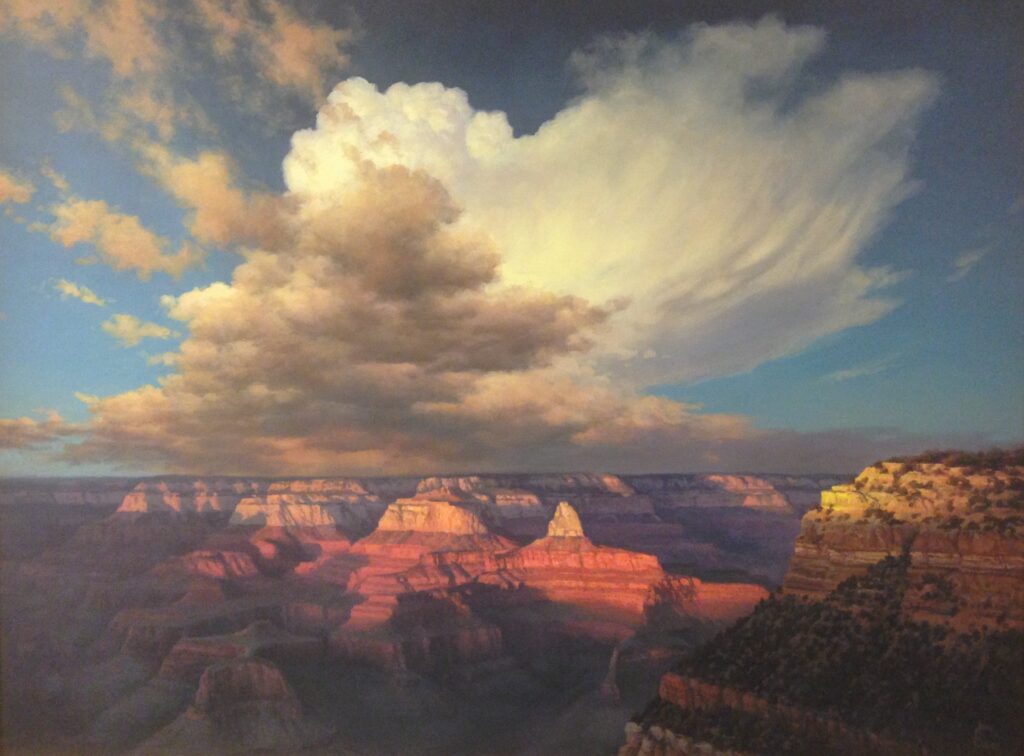
John Cogan
American, born 1953
Eventide
2014
Acrylic on canvas
"My background in science has been extremely helpful to my study of art. Everything in the landscape is influenced by the physics of light, atmosphere and optics. Understanding all the physical properties of a landscape and how the elements affect it enables me to portray it more realistically. …With realism, the artist must understand his medium, composition, color and perspective; additionally he must know how to show light falling on objects, which thereby cast shadows....To me, a painting that gets across the sense that there is light in the scene is the greatest accomplishment."
John Cogan
Art Spotlight
By: Emily Kapes | Curator of Art
Eventide, meaning “the end of the day,” makes for a visually stunning experience in the Grand Canyon, one of the seven natural wonders of the world. Late light intensifies the many striations and facets of the canyon’s interior cliffs and spires with the setting sun’s warm glow. This vista features Brahma and Zoroaster temples, just a few miles from the North Rim.
As grand as the canyon is, however, the sweeping clouds in this painting by John Cogan are just as dynamic. The sky dominates the top two-thirds of the canvas with layers of cloud cover, seemingly on the move across the electric blue sky. The low, dense gray clouds contrast with the towering, bright formations building just behind them. The Grand Canyon’s North Rim sees extreme weather throughout the year, from snowstorms to intense summer afternoon thunderstorms. Each day brings a new sky, new shadows from clouds, and a different perspective on the canyon.
Cogan works at his home studio in Farmington, New Mexico, a five-hour drive from the canyon. He has visited there many times over the years, in every season and in all kinds of weather. His first trip was in 1963 at age 10 when he stayed with his family at Mather Campground. He knew the Grand Canyon was a special place even then, and it has become one of his favorite subjects to paint – he guesses he has depicted its scenes more than 600 times. The variety of viewpoints and varied skies keep bringing him back.
A native Texan, Cogan’s frequent trips to Colorado and New Mexico as a child introduced him to the vast and varied landscapes of the West. He dabbled in painting as a teen, but he didn’t take art seriously until his twenties. He had a laser focus at Rice University, however, earning a Ph.D. in Physics. He worked for a local oil company until 1982, when he left to pursue fine art full-time, seeking personal fulfillment. Cogan’s career as an accomplished landscape painter has spanned almost 40 years.
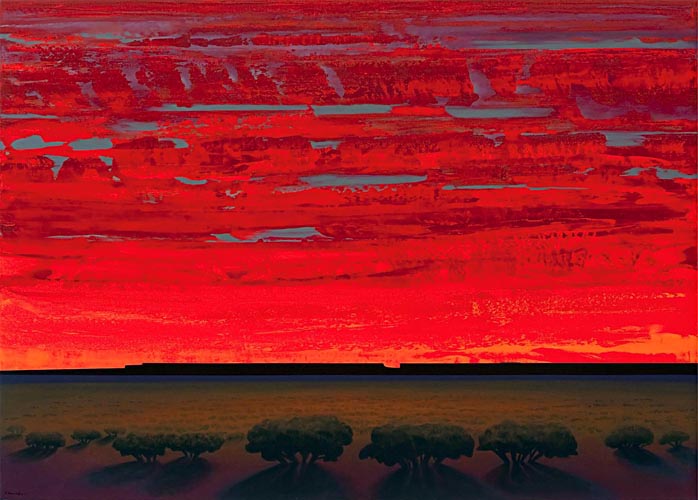
Dan Namingha
Tewa-Hopi, born 1950
Polacca Evening
2009
Acrylic on canvas
Art Spotlight
By: Emily Kapes | Curator of Art
Intense, vibrant, and blazing. A sky so red, a view so vast. Arizona desert skies are ever-changing, with seasons, storms, and the sun. Beneath this fiery late-day sky, First Mesa on the Hopi Reservation is silhouetted in black along the distant horizon. The foreground’s row of lush trees provide greenery in the otherwise open desert, and their deep shadows, lengthened by the lowered sun, enhance a sense of depth to the landscape.
Tewa-Hopi artist Dan Namingha pays reverence to this place, special to him because it is the place of his roots. He was born in Polacca, a village at the base of First Mesa. His Native heritage and respect for the land have inspired a lifetime of art, and countless sunset views as a child likely inspired this scene.
To achieve this brilliant sky, Namingha layered colors in wide brushstrokes, let them partially dry, and then scraped across the canvas with trowels and other tools to reveal a variety of hues. Tangerine nearest to the mesa graduates to maroon at the top of the canvas. The hot reds dominating the sunset glow with powerful intensity, a reminder that light will be back tomorrow. After darkness, a new day will be on its way.
Dan Namingha lives and paints in Santa Fe, New Mexico.
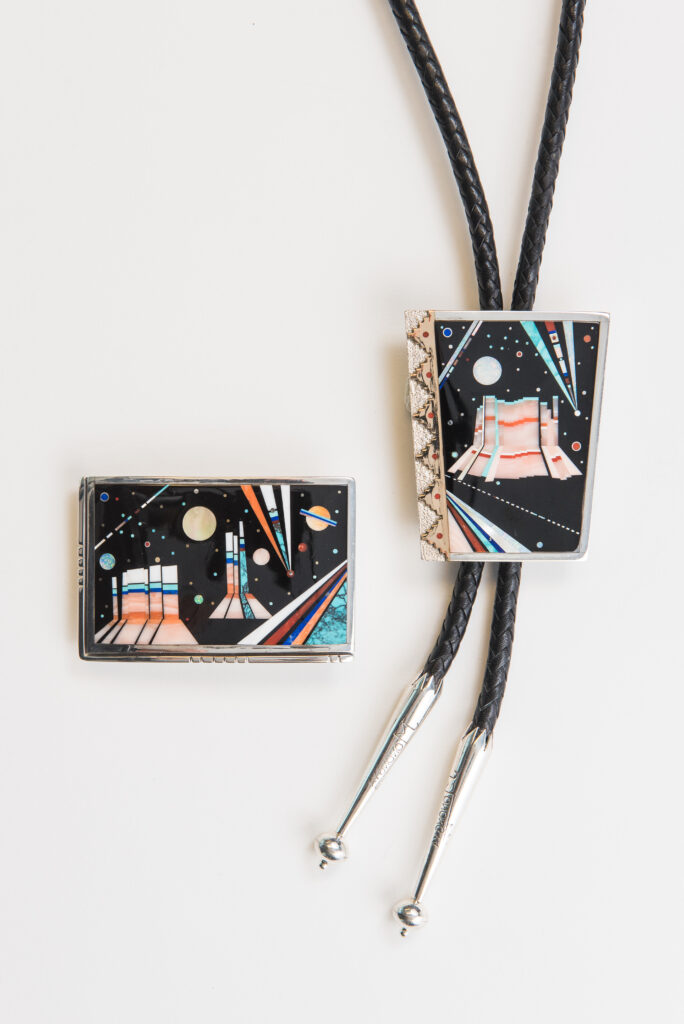
Jesse Monongya
Navajo/Hopi, born 1952
Night Sky Monument Valley Bolo and Buckle
Undated
Bolo: Sterling silver, 14k gold, opal, Acoma jet, Angel Skin coral, turquoise, lapis, Mediterranean coral Buckle: Sterling silver, giant clam shell, opal, gold lip mother-of-pearl, orange spiny oyster, lapis, Acoma jet, Angel Skin coral
Art Spotlight
By: Jason M. Wyatt | Collections Manager
Jeweler Jesse Monongya created this bolo and buckle set depicting the buttes of Monument Valley below a night sky filled with planets, stars, a comet, and the Big Dipper. Monongya is known for the use of the night sky in his designs, with several on display in the museum’s Jewel Box. These two pieces are filled with symbolism of Navajo mythology and astrology. As a child, Monongya learned the constellations and the stories behind them from his Navajo grandmother, who had the remarkable ability to tell the seasons based on the position of the Big Dipper.
In Navajo mythology, the night sky is associated with Black God who brought the ability to make fire to the Navajo people. His father was Fire and his mother was Comet. Black God was also responsible for decorating the dark sky in an orderly fashion with groups of stars in recognizable patterns called constellations. These constellations are used to teach the traditional practices of the Navajo Way of Life. Representations of this God show him with a crescent moon on his forehead, a full moon for a mouth and the Pleiades constellation on his temple.
According to the Navajo, when First Man and First Woman descended into this world, they found a baby girl who quickly grew into Changing Woman. She and the Sun had two babies known as The Twins. This was a time when the world was inhabited by many evil monsters, so Changing Woman hid The Twins in a deep hole for safety. While in this hole, The Twins met Spider Woman who taught them spells and chants. The Twins returned to their mother, and with her help, they used the spells to turn the huge monsters to stone. These stones are the buttes found in Monument Valley.
Books
The James Museum Book Club Recommends…
The Lost Worlds of the Old Ones
By David Roberts
More than a thousand years ago, Native Americans were studying astronomy, watching the sky, and planning their lives and religious rituals around their observations. The Ancestral Puebloans of the Southwest used this knowledge to align buildings with points of the compass or the sun’s rays at solstice or equinox. We know about these ancient people, formerly called the Anasazi, through exploration of the dwellings they left behind at Chaco Canyon, Mesa Verde, and hundreds of other sites.
David Roberts takes us to some of those places, climbing canyon walls, inching along narrow ledges, braving 100-plus degree heat or snow and risking dehydration. It’s an adventure book rather than an academic book, but he also interviews scholars who share their knowledge about the people who inhabited these places. It’s particularly interesting to learn about the Chaco Meridian, a longitude line that intersects several of the most important sites and along which can be found the ruins of signal towers. In addition to hunting the ancients, Roberts searched for the hideout Navajo leader Hoskinini used to evade the government troops that forced thousands of Navajo to walk to an internment camp at Bosque Redondo in the 1860s.
If you like this book, you would also like House of Rain: Tracking a Vanished Civilization Across the American Southwest, a similar adventure account by Craig Childs.
Learn More About Ancient Pueblo Sites
Night skies over Chaco Culture National Historical Park are much the same as they were a thousand years ago, when the ancient Chacoan people inhabited Chaco Canyon. In fact, the park is one of the best places in the country to stargaze and experience natural darkness. (11:31 min)
An update on author David Roberts and etiquette for visiting Ancestral Puebloan sites.
Go deep into the unprotected territory of the Greater Canyonlands region and learn more about the story of this grand landscape. This region of southeastern Utah is a veritable well of human spirit, an endless supply of recreation, solitude, wonder and history. This place and its story are irreplaceable. (8:14 min)
More Books
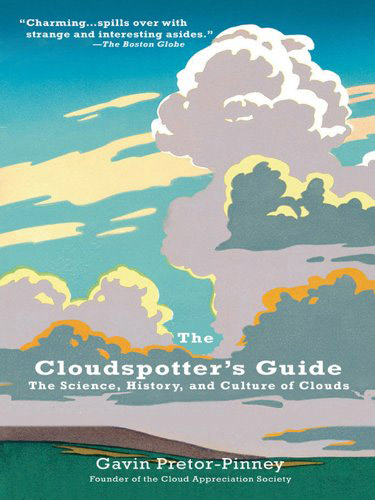
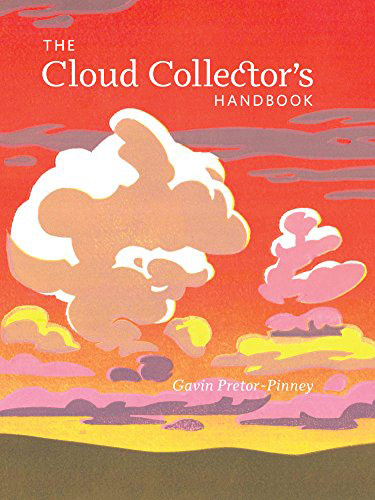
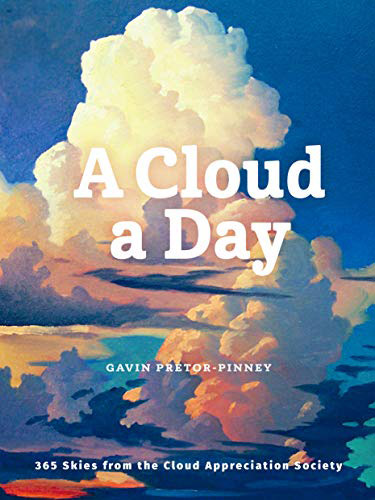
Checks out three books that will keep your head in the clouds. Author Gavin Pretor-Pinney is founder of the Cloud Appreciation Society (https://cloudappreciationsociety.org/), which has more than 40,000 members in 120 countries and was established to fight the banality of ‘blue-sky thinking.’ His internationally bestselling series includes The Cloudspotter’s Guide (2007), The Cloud Collector’s Handbook (2011), and A Cloud A Day (2019), which features 365 stunning images from members and friends of the Cloud Appreciation Society.
Movies
Discover a collection of feature-length and short films that will transport you to through time and space. Learn about cloud inversion at the Grand Canyon, the Northern Lights in Saskatchewan, and an imaginative “Space Western.”
Feature Films

The Martian (2015)
This acclaimed movie is considered one of the great “Space Westerns” of our time. During a manned mission to Mars, Astronaut Mark Watney is presumed dead after a fierce storm and left behind by his crew. But Watney has survived and finds himself stranded and alone on the hostile planet. With only meager supplies, he must draw upon his ingenuity, wit, and spirit to subsist and find a way to signal to Earth that he is alive. Rated PG-13; 150 min.
Short Films
A stunning work of time-lapse sky art, this short film features hypnotizing views of clouds crossing the skies over the American west, the Milky Way and the bowl of stars spinning around the North Star. Combining a documentarian’s eye and a poet’s interpretive sensibilities YIKÁÍSDÁHÁ’s four minutes will inspire you to go outside and gaze at the heavens.
Filmmaker Harun Mehmedinovic captures a remarkable event at Arizona’s Grand Canyon National Park. On extremely rare days, cold air trapped in the canyon and topped by a layer of warm air, in combination with moisture and condensation, form the phenomenon referred to as the full cloud inversion. In what resembles something between ocean waves and fast clouds, the canyon is completely obscured by fog, making visitors feel as if they are walking on clouds.
Science facilitator Wilfred Buck is the man behind the research of a book series called Under a Blanket of Stars: First Nations Constellation. The first book in this series Warren Whistles at the Sky is about the northern lights. Similarly, in this video, Buck shares an intriguing star story from his own childhood.
This animation tells a Cheyenne story of how the Big Dipper came to be when a girl and her loyal brothers escape from a bison. It is one of nine traditional Native American stories that are part of the Smithsonian National Museum of the American Indian inaugural exhibition “Our Universes: Traditional Knowledge Shapes Our World.”
Family Activities
Story Time
Read along with these colorful and engaging stories.
The Man Who Painted the Moon
By Dean Robbins
Illustrated By Sean Rubin
Sky Color
By Peter H. Reynolds
Art Activities
Get creative with inspiration from artists and artwork in
the museum’s collection.
